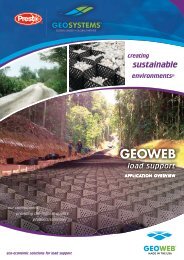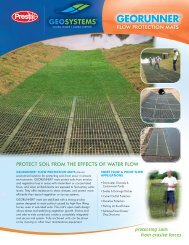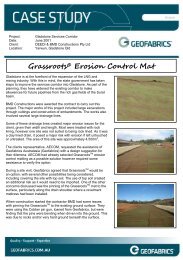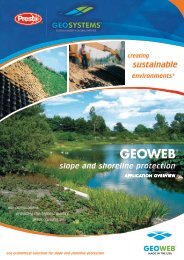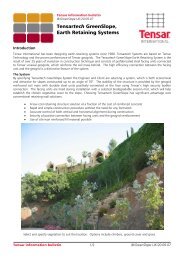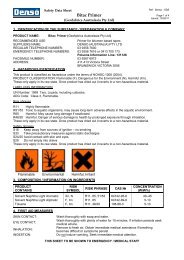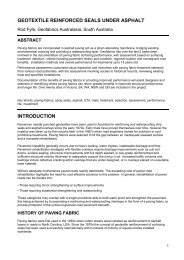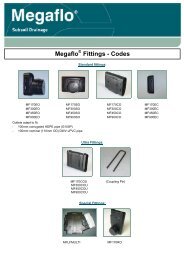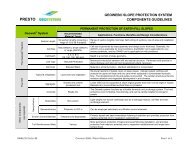An Artificial Reef to Protect Surfers Paradise Beach Developing ...
An Artificial Reef to Protect Surfers Paradise Beach Developing ...
An Artificial Reef to Protect Surfers Paradise Beach Developing ...
You also want an ePaper? Increase the reach of your titles
YUMPU automatically turns print PDFs into web optimized ePapers that Google loves.
<strong>An</strong> <strong>Artificial</strong> <strong>Reef</strong> <strong>to</strong> <strong>Protect</strong> <strong>Surfers</strong> <strong>Paradise</strong> <strong>Beach</strong><br />
<strong>Developing</strong> & Implementing the Science<br />
Mr L.A. Jackson CP Eng<br />
Managing Direc<strong>to</strong>r, International Coastal Management, Southport, Australia.<br />
e-mail: jackson@onthenet.com.au<br />
Mr W.P. Hornsey Pr. Eng<br />
Development Engineer Coastal & Marine, Soil Filters Australia Pty Ltd, Southport Australia.<br />
e-mail: whornsey@soilfilters.com.au<br />
Introduction<br />
The large artificial submerged reef at Narrowneck is constructed only of sand and<br />
geotextile. This reef is an important element in the strategy funded by Gold<br />
Coast City Council <strong>to</strong> protect the world famous <strong>Surfers</strong> <strong>Paradise</strong> beaches from<br />
erosion during s<strong>to</strong>rms. It has provided a huge forward leap in geocontainer<br />
technology and represents the cutting edge of marine geocontainer manufacture<br />
and installation. The reef, although primarily for beach protection, also represents<br />
a major step forward in the dream <strong>to</strong> create artificial surf reefs from user friendly<br />
and cost effective materials. Moni<strong>to</strong>ring of the reef also highlights the behaviour<br />
of geocontainers confirming the need for continued investigation and<br />
development of the science. This article will detail the lessons learned during the<br />
construction and moni<strong>to</strong>ring period and identify areas of research needed in<br />
order <strong>to</strong> better understand this complex field.<br />
© Copyright 2003 Soil Filters Australia Pty Ltd<br />
Figure 1: Aerial View of Narrowneck <strong>Reef</strong>,<br />
created with submerged geotextile containers
Background<br />
The artificial reef is located at Narrowneck at the northern end of <strong>Surfers</strong><br />
<strong>Paradise</strong>, on Australia’s Gold Coast. The Gold Coast is the major coastal holiday<br />
destination in Australia and the economy of the Gold Coast region is dependant<br />
on the <strong>to</strong>urism industry. In order <strong>to</strong> continue <strong>to</strong> attract <strong>to</strong>urist, it is important <strong>to</strong><br />
maintain and protect the wide sandy beaches.<br />
The Gold Coast is in the cyclone belt and the wave buoy nearby has recorded<br />
waves of over 13m. The worst s<strong>to</strong>rm erosion occurred in 1967 when 7 cyclones<br />
affected this section of the east Australian coastline causing extensive damage <strong>to</strong><br />
the Gold Coast beaches and beachfront developments (Figure 2) and resulted<br />
substantial loss in revenue <strong>to</strong> the <strong>to</strong>urist industry.<br />
Ongoing beach nourishment was implemented and has been effective but there<br />
were inadequate long-term sources of suitable sand <strong>to</strong> maintain the beaches<br />
even without the added effects of the predicted sea level rise. Prior <strong>to</strong> the<br />
implementation in 1997of the Northern Gold Coast <strong>Beach</strong> <strong>Protect</strong>ion Strategy<br />
(NGCBPS), the beaches were not wide enough <strong>to</strong> withstand s<strong>to</strong>rm erosion<br />
(Figure 3).<br />
Figure 2: Aftermath of the 1967 Cyclone – <strong>Surfers</strong> <strong>Paradise</strong><br />
© Copyright 2003 Soil Filters Australia Pty Ltd
Objectives<br />
Figure 3: S<strong>to</strong>rm erosion of Narrowneck in March 1996<br />
(taken at high tide before construction of the reef)<br />
The Gold Coast City Council commissioned International Coastal Management <strong>to</strong><br />
determine and implement an appropriate proactive strategy <strong>to</strong> achieve the<br />
following objectives: -<br />
Primary objective:-<br />
• Widen the beach and dunes along the Surfer’s <strong>Paradise</strong> esplanade,<br />
Main <strong>Beach</strong> and Narrowneck <strong>Beach</strong> <strong>to</strong> accommodate s<strong>to</strong>rm erosion<br />
and retreat due <strong>to</strong> sea level rise.<br />
Secondary objective:-<br />
• Improve surfing conditions and beach amenities.<br />
Various schemes were investigated with the following design criteria:-<br />
• Not cause down drift erosion.<br />
• Have low visual impact.<br />
• Not restrict pedestrian flow.<br />
• Not create hazardous conditions.<br />
• Meet regula<strong>to</strong>ry body requirements<br />
© Copyright 2003 Soil Filters Australia Pty Ltd
The preferred option was nourishment of the beach and dunal areas from<br />
navigation channel dredging, stabilised by a submerged reef structure. The ideal<br />
location for the reef was identified at Narrowneck, a short wide headland that<br />
protrudes seaward of the general alignment by approximately 35m and is prone<br />
<strong>to</strong> erosion. Not only was this site well located from a coastal management point<br />
of view but it also has very good parking and public access.<br />
A number of alternative construction materials, including rock &concrete, were<br />
investigated but it was decided <strong>to</strong> construct the reef using Geosynthetic sand<br />
filled containers for the following reasons: -<br />
• Cost: The Geosynthetic structure was approximately half the cost of a<br />
similar rock structure.<br />
• Safety/Public Liability: As the structure would be used by surfers it was<br />
therefore important that risk of injury <strong>to</strong> surfers be minimised. Also, using<br />
sand from the ocean on site for construction meant that the truck traffic<br />
hauling rock or concrete units would not cause a hazard <strong>to</strong> road or beach<br />
users.<br />
• Environmental: Transport of 45,000m 3 of rock from quarries along busy<br />
city roads would increase road traffic emissions in<strong>to</strong> the air as well<br />
increasing the need for road maintenance.<br />
• Ease of removal: As the use of a submerged reef was untested and in<br />
effect a full scale model, approval conditions required that the structure be<br />
able <strong>to</strong> be removed or modified should there be any unforseen adverse<br />
impacts created by the structure. Rock and concrete would have been<br />
expensive if not impossible <strong>to</strong> remove.<br />
The reef concept using sand filled geocontainers was considered a pro<strong>to</strong>type for<br />
the design and construction of future reefs <strong>to</strong> protect other Gold Coast beaches<br />
against s<strong>to</strong>rm erosion and retreat due <strong>to</strong> sea level rise while improving the surfing<br />
amenity. However, it was recognised that the state of the art with respect <strong>to</strong><br />
submerged breakwater design and the use of geocontainers would need <strong>to</strong> be<br />
developed.<br />
Design<br />
The need <strong>to</strong> provide a combination of coastal protection with improved surfing<br />
amenity without hazardous conditions made the design process <strong>to</strong> determine a<br />
suitable shape and location of the structure complex. Specialist consultants<br />
using physical and numerical modelling methods were used during the design<br />
process. The University of New South Wales, Water Research Labora<strong>to</strong>ry<br />
conducted the physical modelling while the University of Waika<strong>to</strong> (New Zealand)<br />
conducted the numerical modelling.<br />
© Copyright 2003 Soil Filters Australia Pty Ltd
The design adopted consisted of a north reef and a south reef with a central<br />
“paddle” channel running perpendicular <strong>to</strong> the coastline (see figure 1) <strong>to</strong> avoid<br />
very high currents over the reef crest that were predicted in the numerical<br />
modelling. The Northern reef extends slightly closer in shore than the southern<br />
reef and this extension was designed <strong>to</strong> trap sand close <strong>to</strong> shore and prevent a<br />
natural bypassing channel from forming. The reef extends 400m offshore and is<br />
200m wide at its widest point (including “paddle” channel). The reef is<br />
constructed in water depths ranging from approximately 2m deep close <strong>to</strong> shore<br />
and 10.5m deep on the outside edge of the reef. The maximum tidal range is<br />
~2m and the reef crest was initially designed at approximately 0.5m below low<br />
water <strong>to</strong> optimise surfing.<br />
Geosynthetic Container Manufacture and placement<br />
The manufacture and filling of the large containers is one of the aspects that<br />
makes this project unique. Previously large containers were manufactured by<br />
placing a sheet of geotextile in<strong>to</strong> a hopper barge filling the barge with material<br />
using an excava<strong>to</strong>r, the edges of the container were then folded inwards and<br />
sewn <strong>to</strong>gether on site. Obviously this was not a simple task when the barge is<br />
moving due <strong>to</strong> the swell conditions and quality control is somewhat limited.<br />
Expressions of interest were called for geotextile suppliers interested in<br />
designing and supplying large geocontainers that could be filled <strong>to</strong> a<br />
predetermined size and would have at least a 25year design life. The<br />
successful supplier, Soil Filters Australia, recommended pre-manufacture of the<br />
containers in a controlled environment with filling and placement of the units by a<br />
split hull hopper.<br />
The Mega Sand containers used were constructed from heavy-duty UV stabilised<br />
polyester Terrafix ® nonwoven needle punched staple fibre geotextile. Quality<br />
assurance was identified as the key <strong>to</strong> the successful deployment and durability<br />
of the Sand Containers. The manufacture of the containers was carried out under<br />
strict supervision and complied with ISO 9001 standards. Specialist sewing<br />
techniques were developed specifically for this project and have proven<br />
themselves in extreme conditions.<br />
The containers were pre-manufactured, with inlet valves and exhaust vents the<br />
only items that requiring closure on board the hopper dredge. This ensures<br />
greater quality assurance as the amount of stitching required in board the moving<br />
vessel was minimised. Developments in the closure methods, such as the double<br />
seal closure, during construction ensured improved long-term durability and<br />
integrity of the closure system.<br />
Nearly 400, 20m long mega sand containers varying from 3.0 metres <strong>to</strong> 4.6<br />
metres in diameter, were placed using the split hulled, trailing suction hopper<br />
dredge, Faucon, fitted with computer interfaced DGPS. This purpose fitted out<br />
vessel, was again unique in that a single vessel was used <strong>to</strong> carry out all the<br />
© Copyright 2003 Soil Filters Australia Pty Ltd
functions required <strong>to</strong> construct the reef from filling the container <strong>to</strong> accurate<br />
location and placement. The containers were accurately filled utilising a<br />
calibrated flow density metre, ensuring repeatability and consistency of the<br />
construction. Containers were filled <strong>to</strong> 80% of maximum theoretical volume. The<br />
marine contrac<strong>to</strong>r McQuade Marine was required <strong>to</strong> work in very difficult<br />
conditions, which became progressively worse as the height of the structure was<br />
raised and increased swell heights above the structure (Figure 4). Not<br />
withstanding these difficult conditions the contrac<strong>to</strong>r was still able <strong>to</strong> manoeuvre<br />
his ship in such a way that containers were generally placed <strong>to</strong> an accuracy of<br />
0.5m. Figures 5 shows two containers placed alongside each other lengthwise<br />
with a gap of approximately 150mm between them.<br />
Placement of the containers was affected by a number of fac<strong>to</strong>rs, namely: -<br />
Tides<br />
Swell size<br />
Swell direction<br />
Wind direction<br />
Extent of beach nourishment<br />
Timing of the beach nourishment had a significant effect on the construction.<br />
Unfortunately the timing of the contract was not ideal and the nourishment<br />
contract ran ahead of schedule, which meant that the expected large seabed<br />
movements would be increased. After examination of options it was decided <strong>to</strong><br />
construct the reef on the seabed, allow settlement and then <strong>to</strong>p up. The cost of<br />
dredging or installation of an effective scour mattresses for these conditions was<br />
excessive.<br />
Figure 4: Installation conditions and dredge, Faucon<br />
© Copyright 2003 Soil Filters Australia Pty Ltd
Figure 5: Placement Accuracy of ± 150mm between containers<br />
Construction commenced in May 1999 and moni<strong>to</strong>ring of individual units and the<br />
<strong>to</strong>tal structure since this time has been carried out <strong>to</strong> determine the behaviour of<br />
the individual units and impacts of the structure. The seabed movements since<br />
commencement have resulted in lowering of the structure and this has provided<br />
data on the effect of crest height on erosion protection, safety and surfing.<br />
Moni<strong>to</strong>ring<br />
The extensive moni<strong>to</strong>ring since construction commenced has included:-<br />
• Video “Argus” imaging using multiple cameras<br />
• Hydrographic and beach surveys.<br />
• Dive inspections.<br />
• Aerial oblique pho<strong>to</strong>graphy.<br />
• Surf parameter observations<br />
• Pressure sensors in and on individual units.<br />
The ARGUS coastal imaging system installed for the Council by the University of<br />
New South Wales is used <strong>to</strong> obtain hourly images from four video cameras and<br />
these are also available <strong>to</strong> the general public via the web. From the images,<br />
sophisticated digital image processing techniques are used <strong>to</strong>:-<br />
• assess beach width,<br />
• assess the three dimensional inter-tidal morphology,<br />
• compare wave breaking on the reef and adjacent offshore sand bars<br />
Settling of the reef has been evident but the reef has proven very robust in its<br />
protection of the beaches and improving the surf. Despite a number of s<strong>to</strong>rms<br />
very little erosion has been observed in the vicinity of the reef and the beach has<br />
maintained an additional ~40 m width relative <strong>to</strong> pre-nourishment conditions.<br />
© Copyright 2003 Soil Filters Australia Pty Ltd
Despite the initial settling, and lower than design crest level, in the analysis of the<br />
wave breaking data a strong trend <strong>to</strong>wards increased wave breaking on the reef<br />
location has been found (see figure 6). The increase of wave breaking from 20%<br />
in January 2000 (during construction) <strong>to</strong> 60% - 80% from March 2000 <strong>to</strong> July<br />
2001 (post construction) can be seen quite clearly (1) . Also, the amount of wave<br />
breaking remains relatively constant from March 2000 <strong>to</strong> July 2001. The analysis<br />
does not consider the quality of the breaking waves for surfing, however the reef<br />
is now more popular with surfers. Not all surfers are happy yet due <strong>to</strong> over<br />
optimistic reporting by media who claimed that the reef would produce the perfect<br />
surf. The balancing between surfing and safety at this early stage has been a<br />
cautious. The moni<strong>to</strong>ring backed by recent wave modelling of the effect of crest<br />
height, lead <strong>to</strong> a decision <strong>to</strong> leave the crest height a 0.5m lower during the first<br />
<strong>to</strong>p up recently. This by no means the end of the surfers dream, in July 2001<br />
large 3m swell was recorded off <strong>Surfers</strong> <strong>Paradise</strong> and pho<strong>to</strong>s were taken <strong>to</strong><br />
asses the quality of the wave breaking on the reef, figure 7 shows the left and<br />
right breaks off the reef and the paddle channel is clearly defined through the<br />
centre.<br />
reef breaking days per month<br />
wave breaking - reef only<br />
(normalised)<br />
wave breaking - hourly (daylight) images per month<br />
35<br />
30<br />
25<br />
20<br />
15<br />
10<br />
5<br />
0<br />
1.0<br />
0.8<br />
0.6<br />
0.4<br />
0.2<br />
0.0<br />
300<br />
250<br />
200<br />
150<br />
100<br />
50<br />
0<br />
Pol ynomial fit<br />
Jan-00 Apr-00 Jul-00 Oct-00<br />
2000<br />
Jan-01 Apr-01 Jul-01<br />
Gold Coast <strong>Reef</strong><br />
adjacent s<strong>to</strong>rm bar<br />
Figure 6: <strong>Reef</strong> Wave Breaking data indicate a trend <strong>to</strong>ward increased wave<br />
breaking on the artificial reef<br />
© Copyright 2003 Soil Filters Australia Pty Ltd
Figure 7: Waves breaking on Narrowneck <strong>Reef</strong><br />
The design team <strong>to</strong>gether with the geotextile container supplier carry out regular<br />
dives on the reef in order <strong>to</strong> assess the durability and stability of the containers.<br />
This moni<strong>to</strong>ring confirms that the containers are not deforming beyond what was<br />
allowed for in the design of the structure. Back analysis of the geocontainers<br />
using the GeoCops program produced an expected shape of the container filled<br />
on dry land these dimensions are compared with field data obtained from the<br />
moni<strong>to</strong>ring dives. Figure 8 shows the calculated shape as the dashed line while<br />
the solid line defines the actual shape of the container measured in place.<br />
2 100 mm<br />
4 600 mm<br />
4 950 mm<br />
1 800 mm<br />
2 300 mm<br />
Figure 8: Container Shape<br />
5 900 mm<br />
6 500 mm<br />
2 000 mm<br />
It is clear from the moni<strong>to</strong>ring that the containers have deformed slightly when<br />
compared <strong>to</strong> the undisturbed dimensions. However this difference was expected<br />
as the containers are placed under considerable stress when exiting the hopper<br />
and in some cases fall though 8m of water before landing on the seabed. Up <strong>to</strong><br />
20% reduction in height was allowed for in the design but the actual reduction in<br />
height is closer <strong>to</strong> the 15% mark. Continued moni<strong>to</strong>ring of the containers has<br />
shown that the container shape has remained stable since installation.<br />
© Copyright 2003 Soil Filters Australia Pty Ltd
Lessons Learned<br />
The GCCC expressed concern over damage <strong>to</strong> containers due <strong>to</strong> surfboard fins,<br />
therefore various coatings were trialed in order <strong>to</strong> improve puncture resistance.<br />
These protective coatings trials showed that as the coatings became more rigid<br />
(less flexible), the greater the chance of damage. The most successful protection<br />
<strong>to</strong> the geotextile was achieved by producing a composite geotextile. This<br />
consisted of the primary geotextile (the geotextile which must withstand filling<br />
and placement stresses), with a secondary coarse staple fibre layer needled <strong>to</strong><br />
the surface. The secondary layer adds no structural strength <strong>to</strong> the primary<br />
geotextile and does not reduce the high elongation characteristics but it does trap<br />
up <strong>to</strong> 5kg/m 2 of sand in the structure thereby significantly increasing the puncture<br />
resistance of the geotextile. The secondary layer also protects the primary<br />
geotextile from abrasion and UV degradation<br />
The shape of the containers is very important, no part of the container must be<br />
allowed <strong>to</strong> flap with the movement of the swell over the containers. This continual<br />
flapping motion causes fatigue in the geotextile and can lead <strong>to</strong> rupturing of the<br />
containers.<br />
The containers are placed in a highly abrasive environment and only the most<br />
abrasion resistant geotextiles should be used in this type of application. <strong>An</strong>y<br />
geotextile proposed for use in this application should undergo vigorous testing.<br />
The German “Baudesanstalt fur Wasserbau” (2) rotating drum test method is<br />
recommended, as it best replicates abrasive near shore surf environment.<br />
In order <strong>to</strong> ensure a quality finished product containers must be manufactured in<br />
a controlled environment not on site. Specialised stitching methods and<br />
configurations should be applied when manufacturing the containers as the<br />
stitching is placed under repeated severe stress during the filling and placement<br />
operation. The seam strength becomes more important as the geotextile<br />
becomes more rigid (lower elongation) as the stresses appear <strong>to</strong> become<br />
concentrated on the seams rather than dissipated throughout the geotextile.<br />
The on site inlet and exhaust valve closures are the only areas in the container,<br />
which are not carried out under any quality assurance system. Conditions under<br />
which theses closures are made are far from ideal, particularly during rough seas<br />
and should therefore include a failsafe mechanism. The failsafe mechanism used<br />
in this project was a double seal configuration, which made use of two<br />
independent systems <strong>to</strong> close the valve. This meant that should there be a failure<br />
of one of the seals that the second seal would not be affected by the failure of the<br />
first and maintains the integrity of the closure. This will in increase container<br />
fac<strong>to</strong>r of safety significantly. Compromising a small detail such as this can lead <strong>to</strong><br />
the failure of the container as a whole.<br />
© Copyright 2003 Soil Filters Australia Pty Ltd
Some damage <strong>to</strong> the containers is inevitable, be it during the placement<br />
operation or from pleasure boats anchoring on the reef, however underwater<br />
repairs <strong>to</strong> containers is possible. Patching devices and techniques were<br />
developed during the contract, which will allow ongoing maintenance <strong>to</strong><br />
submerged geotextile containers. Although patching was never considered<br />
during the adjudication of tenders it should be considered in future projects.<br />
As with any other construction material placed on the seabed, some settlement<br />
of the containers in<strong>to</strong> the seabed must be expected. However if containers are<br />
placed on a newly nourished and unconsolidated seabed significant settlement of<br />
the structure can be expected.<br />
The open structure of the geotextile provides an ideal platform for the<br />
colonisation of marine life. Marine algae begins <strong>to</strong> grow on the containers as<br />
soon as they are placed and are generally completely covered in up <strong>to</strong> 300mm<br />
long growth within 3 months. It also appears as if the composite geotextile<br />
provides a better substrate for the colonisation of marine life than say epoxycoated<br />
geotextiles. The reef has now become a favourite fishing and diving spot<br />
as well as for surfing.<br />
Conclusion<br />
Construction of the Narrowneck <strong>Reef</strong> using thick nonwoven needle punched<br />
staple fibre geotextiles has proved their effectiveness in marine conditions<br />
beyond doubt. The nourished and stabilised beach is now wide and able <strong>to</strong><br />
withstand s<strong>to</strong>rm wave attack (Figure 9), both figure 3 and figure 9 taken a high<br />
tide.<br />
While a great deal is yet <strong>to</strong> be learnt about the use of geocontainers in artificial<br />
reefs, this project has pushed the boundaries of geocontainer use <strong>to</strong> new levels<br />
and raised new questions. The reef has provided a full scale model <strong>to</strong> measure<br />
and observe raising questions such as “why is there little turbulence around the<br />
containers?” and “why is settlement in<strong>to</strong> the seabed minimal?” – note: rocks have<br />
an expensive habit of disappearing in<strong>to</strong> large scour holes that form around rock.<br />
International Coastal Management and Soil Filters Australia are involved with<br />
ongoing research <strong>to</strong> answer these and other questions. Pressure transducers<br />
inserted in<strong>to</strong> a bag have already helped understand the way in which the sand<br />
filled containers actually absorb wave energy. However, further research in<strong>to</strong><br />
areas such as stability, durability, energy absorption and the best layouts for<br />
surfing is still <strong>to</strong> be completed.<br />
© Copyright 2003 Soil Filters Australia Pty Ltd
Figure 9: Narrowneck after s<strong>to</strong>rms in March 2001 (c/f figure3)<br />
The moni<strong>to</strong>ring of the Narrowneck pro<strong>to</strong>type has provided extensive “real world”<br />
data that has influenced the design of the Noosa and Palm <strong>Beach</strong> reefs<br />
programmed for commencement in 2002-03.<br />
The success of this project has been possible due <strong>to</strong> the close working<br />
relationship involving ongoing Research and Development between Client,<br />
Engineer, Geosynthetic Supplier and Contac<strong>to</strong>r.<br />
References<br />
1. Turner, I.L., Dronkers, T.D.T., Roman, C., Aarninkhof, S.G.J., McGrath, J.,<br />
2001. The application of Video Imaging at the Gold Coast <strong>to</strong> Quantify <strong>Beach</strong><br />
Response <strong>to</strong> Sand Nourishment and Construction of an <strong>Artificial</strong> <strong>Reef</strong>.<br />
Proceedings, 8 th Australian Port and Harbour Conference, <strong>Surfers</strong> <strong>Paradise</strong>,<br />
Australia, 55-60.<br />
2. Federal Waterways Engineering & Research Institute, 1994. Guidelines for<br />
testing of geotextiles in hydraulic engineering applications.<br />
Acknowledgements<br />
Dr I Turner, University of New South Wales, Water Research Labora<strong>to</strong>ry for the<br />
latest wave breaking data.<br />
Mr J McGrath, Gold Coast City Council, for the 1967 s<strong>to</strong>rm damage pho<strong>to</strong>.<br />
The authors supplied all other pho<strong>to</strong>’s.<br />
© Copyright 2003 Soil Filters Australia Pty Ltd



